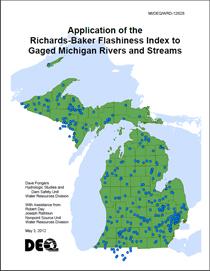Examples of Geomorphology Assessments for Watershed Health
Watershed inputs (water, sediment and organic matter) and valley characteristics (valley slope and width, bedrock and surficial geology, soils and vegetation) determine a river channel’s form (pattern, profile and dimension). Although watershed inputs and channel form vary over time, they are balanced in natural systems. This natural balance is termed “dynamic equilibrium” and refers to sediment size and volume being in balance with stream slope and discharge. Any time one of these variables changes, the other variables will respond to bring the stream back to a dynamic equilibrium.
Disturbances such as floods or forest fires are natural, episodic events that cause a stream to become unbalanced. After such disturbances, the stream will “seek” equilibrium conditions through adjustment of the other components until the stream is once again in a form that allows it to efficiently perform its functions of water and sediment discharge.
These periodic disturbances, of natural intensity and frequency, can increase aquatic biodiversity by creating opportunities for some species and scaling back the prevalence of others. When disturbances are of extreme intensity or frequency, as many human disturbances are, a stream channel will undergo adjustment to a new form. This can result in habitat degradation and threats to public safety and infrastructure.
You may need a PDF reader to view some of the files on this page. See EPA's PDF page to learn more. Most of the following links exit the site. EXIT
National
Watershed Assessment of River Stability and Sediment Supply (WARSSS) Developed by Dr. David L. Rosgen, WARSSS is a three-phase technical framework of methods for assessing suspended and bedload sediment in rivers and streams. WARSSS can be used to analyze known or suspected sediment problems, develop sediment remediation and management components of watershed plans, develop sediment TMDLs (Total Maximum Daily Loads) and for other uses.
Framework for Developing Suspended and Bedded Sediments (SABS) Water Quality Criteria Suspended and bedded sediments (SABS) are defined by EPA as particulate organic and inorganic matter that suspend in or are carried by the water and/or accumulate in a loose, unconsolidated form on the bottom of natural water bodies. SABS occur naturally in all types of water bodies. In appropriate amounts, sediments are essential to aquatic ecosystems. They can contribute to essential habitat for aquatic species’ growth and reproduction. However, imbalanced sediment supply has repeatedly ranked high as a major cause of waterbody impairment. The Framework consists of a stepwise process for developing criteria for SABS. It includes gathering information, synthesizing the state of knowledge, analyzing available data, gathering more data if needed and selecting criteria values. SABS criteria can then be implemented within a comprehensive management plan.
Regional
Riparian Area Management: Process for Assessing Proper Functioning Condition (PDF) (58 pp, 1.9MB) Proper Functioning Condition is a qualitative watershed assessment tool developed by the Bureau of Land Management that assesses proper functioning of riparian-wetland areas and the condition of these areas based on observations focusing on the physical condition of the channel and riparian-wetland area. PFC is used widely in the West as a quick assessment tool to determine the stream’s stability and identify management practices that need to be changed in order to improve channel conditions. The basic question PFC answers is whether or not a stream channel and its corresponding wetland-riparian area can withstand high flow events, e.g., 5-, 10-, and 20-year events without significant loss of integrity. PFC can be used to identify riparian-wetland systems for protection.
State
Vermont Stream Geomorphic Assessment Program Vermont Department of Environmental Conservation places a strong emphasis on fluvial geomorphology in its approach to protecting and restoring Vermont’s streams and rivers. The geomorphic assessment program collects and maintains geomorphic data for watershed planning and detailed characterization of riparian and instream habitat, stream-related erosion and flood hazards. It has produced a number of resources to explain principles of fluvial geomorphology, its relevance to aquatic ecosystem management and protocols for geomorphic assessments.
 Application of the Richards-Baker Flashiness Index to Gaged Michigan Rivers and Streams (PDF) (149 pp, 4.9MB) Stream flashiness is a stream flow response to storms. Streams that rise and fall quickly are considered flashier than those that maintain a steadier flow. An increase in flashiness, often due to changing land use, is a common cause of stream channel instability. The Richards-Baker Flashiness Index (R-B Index) uses data from United States Geological Survey (USGS) gaging stations to quantify the frequency and rapidity of short-term changes in stream flow.
Application of the Richards-Baker Flashiness Index to Gaged Michigan Rivers and Streams (PDF) (149 pp, 4.9MB) Stream flashiness is a stream flow response to storms. Streams that rise and fall quickly are considered flashier than those that maintain a steadier flow. An increase in flashiness, often due to changing land use, is a common cause of stream channel instability. The Richards-Baker Flashiness Index (R-B Index) uses data from United States Geological Survey (USGS) gaging stations to quantify the frequency and rapidity of short-term changes in stream flow.
The Michigan Department of Environmental Quality (MDEQ) Nonpoint Source (NPS) Program staff calculated R-B Index values and assessed trends for 308 USGS gages in Michigan watersheds that had at least five years of data through the end of water year 2011. This report describes the flashiness analysis methodology and results. The information should also be useful to those interpreting other data, such as watershed development trends, stream bank erosion rates or biological survey data. This information can be incorporated into stream stability assessments and watershed management plans. Watershed stakeholders should also find it useful as an aid to Best Management Practices (BMPs) selection and design.
